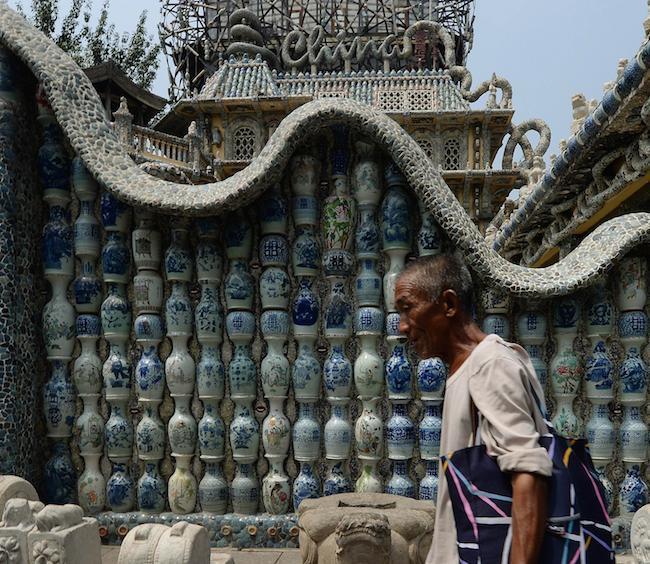The pet project of a wealthy businessman, China House is a palace built of porcelain.
Above image: China House. Photograph by Mark Ralston/AFP.
Zhang Lianzhi is a collector who owns a successful restaurant chain. In 2002 he bought a large, moldering building in Tianjin Municipality, in an old commercial district. The 100 year-old building is built in a French style and once belonged to a finance minister in the late Qing Dynasty (1644-1911), according to reports. After a brief stint as a bank in the 1940s, the house was deserted, which was how Zhang found it.
In that building, Zhang saw a way to showcase his enormous collection. It would be a mosaic project writ large, an homage to culture. CCTV reports that artists adorned the outer wall and the facade of the home with more than 5,000 ancient vases, supported by 4,000 plates, 300 pieces of marble statuary and an incredible 400 million shards of porcelain. Many of these works date back to the Tang Dynasty (CE 618 – 907). They cover an area so large that the shards (what I think of when I think of mosaic works) only form the background of the work. Whole vases and plates are patterned and arranged as though they were no bigger than chunks of broken tile. In the videos we can see workers setting shards into marble statues, giving us a chilling shot of a marble warrior being consumed by a creeping wave of porcelain.

The private museum was finished in 2007. Estimates place its cost at about $306 million. The bulk of the house’s effect is visible from the street. The outwardness of the work is the point. Thousands of years of culture made immutable by the solidness of the wall are set right in front of passers by. They can examine it from inches away. They can touch it and connect with it.
For better or worse, that is. The articles I read said the building is controversial because ancient works were being forever altered; they lose some of their worth. I can understand that. Even though it’s a reflex more than a judgment, I feel a little uncomfortable seeing these objects treated like common bricks. Whole sections of these pieces are forever buried under concrete. This means that this monument to art and culture is erasing pieces of that culture even as it enshrines it. There’s also the question of scale. All of these vases are competing against the relative volume of the whole, which means that no single piece can be appreciated entirely on its own. Then there’s the question of motive. Is this a gift to the public or a businessman’s Xanadu? Are we meant to appreciate the work or the audacity and power of the person who presented us with the work?
These questions are familiar, while being stretched to strange new proportions. This house was built in the outer limits of Ai WeiWei’s Dropping of a Han Dynasty Urn.

Click to see a larger image.

But if you like large, loud pottery-inspired architecture, you might want to check out the Liling Ceramic Museum. If you like maximalist, painstakingly-crafted mosaic homes you would be interested in our story about Raymond Isidore. Zhang Lianzhi’s “China House” bridges these two themes and turns them into something new.
Bill Rodgers is the Managing Editor of cfile.daily.
What do you think of contemporary ceramic art appropriating ancient ceramic art? Let us know in the comments.














I love the fact that he has shared his treasures and anyone can look or touch. So what if some of them are ‘priceless’, what is the point in keeping beautiful things locked away safe and only the honored few get to see. I really like his concept, altering somethings purpose is not a bad thing. Locked away in darkness is a bad thing. His work is not Odd it’s just different, in a world where sameness is forced upon us.
I would have liked a voice-over or sub-titles to help me understand what was said.
Perhaps this house inspired Ai wei wei to smash an ancient vase and paint over others?